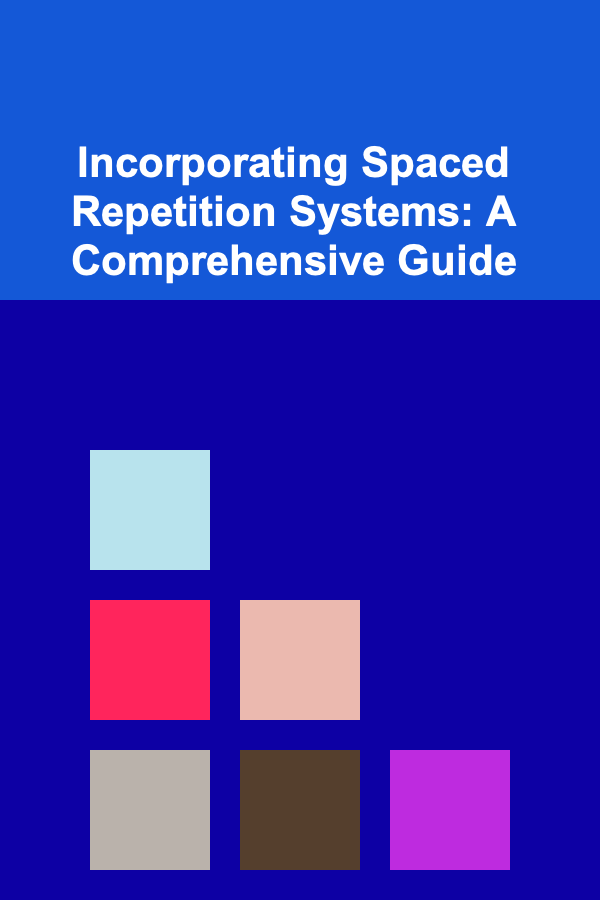
Incorporating Spaced Repetition Systems: A Comprehensive Guide
ebook include PDF & Audio bundle (Micro Guide)
$12.99$6.99
Limited Time Offer! Order within the next:

Spaced Repetition Systems (SRS) are powerful learning tools that leverage the psychological spacing effect to optimize long-term retention. Unlike rote memorization, which involves cramming information in a short period, SRS algorithms schedule review sessions at increasing intervals. This forces your brain to actively recall the information, strengthening neural pathways and dramatically improving memory.
Understanding the Fundamentals of Spaced Repetition
At its core, spaced repetition is based on the principle that memory is strengthened by repeated recall at increasing intervals. When you first learn something, the interval between reviews needs to be short. If you successfully recall the information, the interval is increased. If you fail, the interval is shortened. This dynamic adjustment allows the system to focus on the information you struggle with most, making learning more efficient and effective.
The Spacing Effect
The spacing effect is a cognitive phenomenon that demonstrates that information is better remembered when learning is spaced out over time, rather than crammed into a single session. This is because spaced repetition forces active recall, which strengthens the memory trace. Think of it like this: constantly hammering a nail into wood in the same spot weakens the wood. But tapping it occasionally allows the wood to strengthen around the nail.
Active Recall vs. Passive Review
Spaced repetition hinges on active recall. Active recall means you're actively trying to retrieve the information from your memory without looking at the answer first. This is different from passive review, where you simply re-read or re-listen to the material. Active recall is significantly more effective for long-term retention because it challenges your brain and strengthens the neural pathways associated with the information.
The Forgetting Curve
The forgetting curve, popularized by Hermann Ebbinghaus, illustrates the exponential decay of memory over time. Without reinforcement, we rapidly forget newly learned information. Spaced repetition aims to combat the forgetting curve by strategically scheduling reviews before the information fades from memory. By reinforcing the memory trace at optimal intervals, SRS helps to flatten the forgetting curve and significantly extend the lifespan of what you learn.
Choosing the Right Spaced Repetition System
Numerous SRS tools are available, each with its own strengths and weaknesses. Selecting the right one depends on your learning style, the type of material you're studying, and your technical proficiency.
Anki: The Powerhouse of Customization
Anki is arguably the most popular and versatile SRS program. It's a free and open-source flashcard program that allows for extensive customization. You can create your own decks, use shared decks created by other users, and adjust the algorithm to fit your specific needs.
Pros:
- Highly Customizable: Anki offers a wide range of options for card types, scheduling algorithms, and add-ons, allowing you to tailor the system to your specific learning needs. You can use images, audio, and LaTeX formatting to create engaging and effective flashcards.
- Cross-Platform Compatibility: Anki is available on Windows, macOS, Linux, iOS, and Android, allowing you to study on any device. Your decks are synced across all your devices, so you can seamlessly switch between studying on your computer and your phone.
- Extensive Add-On Support: A large community of users has created countless add-ons for Anki, extending its functionality in various ways. These add-ons can help you with everything from automatically generating cloze deletions to tracking your progress in more detail.
- Free and Open Source: Anki is completely free to use on computers and Android devices. The iOS app has a one-time fee, which helps support the development of the software.
- Large Community and Shared Decks: A huge community of Anki users shares decks on a variety of topics, from language learning to medical science. This can save you a lot of time and effort in creating your own cards.
Cons:
- Steep Learning Curve: Anki's extensive customization options can be overwhelming for beginners. It takes time to learn how to effectively use the program and optimize your settings.
- Card Creation Can Be Time-Consuming: Creating high-quality flashcards can be a time-consuming process, especially if you're learning complex material.
- Algorithm Requires Fine-Tuning: The default algorithm may not be optimal for everyone. You may need to experiment with different settings to find what works best for you.
Memrise: Gamified Learning
Memrise takes a more gamified approach to spaced repetition. It uses a variety of memory aids and interactive exercises to make learning more engaging and fun. It's particularly popular for language learning, but can be used for other subjects as well.
Pros:
- Gamified Learning Experience: Memrise incorporates game-like elements such as points, badges, and leaderboards to motivate users and make learning more enjoyable.
- Mnemonic Devices (Mems): Memrise allows users to create and share mnemonic devices, called "Mems," to help them remember information. These Mems can be images, sounds, or anything else that helps you associate the information with something memorable.
- Large Library of Courses: Memrise offers a vast library of courses created by both Memrise staff and other users, covering a wide range of subjects.
- User-Friendly Interface: Memrise has a clean and intuitive interface that is easy to use, even for beginners.
Cons:
- Less Customization than Anki: Memrise offers less customization than Anki. You have less control over the scheduling algorithm and the design of your learning materials.
- Subscription Required for Full Access: While Memrise offers a free version, you need to subscribe to Memrise Pro to access all the features and content.
- Content Quality Can Vary: The quality of user-created courses can vary significantly. It's important to carefully evaluate the course before you invest your time in it.
SuperMemo: The Pioneer of Spaced Repetition
SuperMemo is the original spaced repetition system, developed by Piotr Wozniak. It's known for its sophisticated algorithm and its focus on long-term retention. However, it has a steeper learning curve than Anki and Memrise.
Pros:
- Highly Optimized Algorithm: SuperMemo's algorithm is considered by many to be the most sophisticated and effective spaced repetition algorithm available. It takes into account a wide range of factors, such as your past performance, the difficulty of the material, and your overall learning ability.
- Focus on Long-Term Retention: SuperMemo is designed to help you retain information for years, or even decades.
- Incremental Reading: SuperMemo supports incremental reading, a technique that allows you to gradually learn complex material by breaking it down into smaller pieces.
Cons:
- Steep Learning Curve: SuperMemo has a complex interface and a steep learning curve. It takes a significant amount of time and effort to learn how to use it effectively.
- Expensive: SuperMemo is a commercial software and is more expensive than Anki, which is free.
- Less Community Support: SuperMemo has a smaller community of users than Anki, so it may be harder to find help if you run into problems.
- Complex Interface: The user interface can feel outdated and difficult to navigate compared to more modern SRS tools.
Other Options
Besides Anki, Memrise, and SuperMemo, other SRS options exist. These include:
- Quizlet: Popular for creating and sharing flashcards, Quizlet offers various study modes, including spaced repetition.
- Brainscape: Focuses on confidence-based repetition, where you rate how well you know a concept.
- RemNote: Combines note-taking with spaced repetition.
- Mnemosyne: Another free and open-source SRS program.
The best way to choose an SRS is to experiment with a few different options and see which one best fits your learning style and needs.
Creating Effective Flashcards
The effectiveness of spaced repetition hinges on the quality of your flashcards. Poorly designed flashcards can hinder your learning progress, while well-designed ones can significantly enhance your retention.
Keep It Simple
Each flashcard should focus on a single concept or idea. Avoid cramming too much information onto a single card. Simplicity promotes clarity and facilitates recall. Instead of trying to learn everything about a topic at once, break it down into smaller, more manageable chunks.
Use the Minimum Information Principle
Include only the essential information on each card. Avoid adding extraneous details that could distract you or clutter your mind. The goal is to distill the information down to its core essence.
Formulate in Question/Answer Format
Frame your flashcards as questions and answers. This forces you to actively recall the information when you review the card. Avoid using simple fill-in-the-blank statements, as they don't require as much active recall.
Use Images and Visual Aids
Images and visual aids can make your flashcards more engaging and memorable. Visuals can help you to connect the information to concrete concepts and improve your understanding.
Prioritize Understanding Over Memorization
Don't just memorize facts. Strive to understand the underlying concepts. This will make the information more meaningful and easier to remember in the long run. Whenever possible, try to relate the new information to what you already know.
Use Cloze Deletions (Fill-in-the-Blanks) Strategically
Cloze deletions can be useful for memorizing specific facts or vocabulary, but they should be used sparingly. Make sure that the context is clear and that there is only one possible answer. Avoid overly complex cloze deletions that require you to guess the answer.
Examples of Good and Bad Flashcards
Bad Flashcard:
Front: The French Revolution
Back: A period of social and political upheaval in late 1700s France. Caused by widespread discontent with the monarchy and the poor economic policies of Louis XVI. Resulted in the overthrow of the monarchy and the establishment of a republic. Key events include the storming of the Bastille, the Reign of Terror, and the rise of Napoleon Bonaparte.
Why it's bad: Too much information on one card. Passive recall only. Lacks a specific question.
Good Flashcard:
Front: What event is considered the start of the French Revolution?
Back: The storming of the Bastille
Why it's good: Focuses on a single concept. Uses a question format. Concise and clear answer.
Another Good Flashcard (using image):
Front: [Image of the Palace of Versailles]
Back: What palace was the primary residence of the French monarchs, including Louis XIV, XV, and XVI?
Why it's good: Uses an image to aid recall. Asks a specific question. Connects a visual with a fact.
Effective Strategies for Using Spaced Repetition
Even with the best SRS and well-crafted flashcards, effective learning requires strategic implementation. Here are some best practices to maximize your learning outcomes:
Consistency is Key
The most important factor in the success of spaced repetition is consistency. Make sure to review your cards regularly, even if it's just for a few minutes each day. Skipping days or weeks can significantly reduce the effectiveness of the system.
Don't Cram
Spaced repetition is not a substitute for understanding. Don't try to cram information into your brain right before an exam. Instead, use spaced repetition as a way to reinforce your learning over time. While short-term cramming might get you through an exam, you'll likely forget the information shortly afterward.
Understand Before Memorizing
Before you create flashcards, make sure you understand the underlying concepts. Spaced repetition is most effective when you're reinforcing existing knowledge, not trying to learn something new from scratch. If you don't understand something, take the time to research it and learn it thoroughly before creating flashcards.
Adjust Intervals Based on Performance
Pay attention to your performance and adjust the intervals accordingly. If you're consistently failing to recall information, shorten the intervals. If you're consistently recalling information easily, lengthen the intervals. Most SRS programs allow you to adjust the intervals manually.
Use Mnemonics and Memory Aids
Mnemonics and other memory aids can help you to remember information more easily. Use them whenever possible to make your flashcards more memorable. Consider using acronyms, rhymes, or visual imagery to create strong associations with the information you're trying to learn.
Break Down Large Tasks
If you have a large amount of information to learn, break it down into smaller, more manageable chunks. This will make the learning process less overwhelming and more effective. Create separate decks for different topics or subjects.
Review Failed Cards More Frequently
Pay special attention to the cards that you fail to recall. Review these cards more frequently until you master them. Most SRS programs have a "failed cards" feature that allows you to focus on these cards.
Vary Your Learning Methods
Spaced repetition is a powerful tool, but it's not the only learning method you should use. Combine it with other techniques, such as reading, listening to lectures, and participating in discussions, to create a well-rounded learning experience. Consider using the Feynman Technique, active recall journaling, or mind mapping to complement your SRS learning.
Optimize Your Learning Environment
Find a quiet and distraction-free environment where you can focus on your studies. Avoid multitasking or studying when you're tired or stressed. A conducive learning environment can significantly improve your concentration and retention.
Adapting Spaced Repetition to Different Subjects
Spaced repetition can be adapted to a wide range of subjects, from language learning to science to history. However, the specific strategies you use may need to be adjusted depending on the subject matter.
Language Learning
For language learning, focus on vocabulary, grammar, and pronunciation. Use flashcards to memorize new words and phrases, and create sentence examples to practice grammar. Use audio recordings to improve your pronunciation. Anki is particularly well-suited for language learning due to its ability to incorporate audio and images into flashcards.
Science
For science, focus on understanding key concepts and principles. Use flashcards to memorize definitions, formulas, and diagrams. Create examples to illustrate the application of the concepts. Make sure you understand the underlying logic and reasoning behind the scientific principles. Draw connections between different concepts and build a strong understanding of the subject matter.
History
For history, focus on understanding the causes and consequences of events. Use flashcards to memorize dates, names, and places. Create timelines to understand the sequence of events. Focus on the big picture and try to understand the historical context. Avoid simply memorizing facts without understanding their significance.
Medicine
Spaced repetition is extremely popular in medical school. Focus on anatomy, physiology, pharmacology, and pathology. Use flashcards to memorize anatomical structures, physiological processes, drug mechanisms, and disease characteristics. Use image occlusion to test your knowledge of anatomical diagrams. Many pre-made Anki decks exist specifically for medical students.
Troubleshooting Common Problems
Even with the best strategies, you may encounter some problems when using spaced repetition. Here are some common issues and how to address them:
Feeling Overwhelmed
If you're feeling overwhelmed by the number of cards you need to review, break them down into smaller batches. Focus on reviewing a few cards at a time and gradually increase the number as you become more comfortable. You can also use the "suspend" feature in Anki to temporarily hide cards that you're not ready to review.
Difficulty Recalling Information
If you're having difficulty recalling information, review the underlying concepts more thoroughly. Make sure you understand the material before you try to memorize it. Try different memory aids, such as mnemonics or visual imagery. Rewrite the flashcard in simpler terms or break it down into smaller components.
Boredom
If you're feeling bored, try mixing up your learning methods. Combine spaced repetition with other techniques, such as reading, listening to lectures, or participating in discussions. Explore different Anki add-ons to change the presentation of your cards or add new features.
Algorithm Issues
If you're experiencing problems with the algorithm, experiment with different settings. Adjust the intervals, the ease factor, and the learning steps to find what works best for you. Consult the documentation or online forums for your SRS program for more information.
Conclusion
Spaced Repetition Systems are a highly effective tool for long-term retention. By understanding the principles of the spacing effect, active recall, and the forgetting curve, and by choosing the right SRS, creating effective flashcards, and implementing strategic learning techniques, you can significantly enhance your learning outcomes. Consistency, understanding, and adaptation are key to success. So, embrace the power of spaced repetition and unlock your full learning potential.
Reading More From Our Other Websites
- [Home Renovating 101] How to Choose the Right Backsplash for Your Kitchen Renovation
- [Home Renovating 101] How to Identify and Fix Common Issues Before House Flipping to Avoid Costly Surprises
- [Home Renovating 101] How to Create a Spa-Like Bathroom in Your Home Renovation
- [Personal Investment 101] Monetizing Pre-Trained Deep Learning Models for Profit
- [Personal Finance Management 101] How to Build an Investment Portfolio with Limited Funds
- [Organization Tip 101] How to Create a Fishing Gear Inventory Checklist
- [Personal Investment 101] How to Get Started with Angel Investing for High-Growth Opportunities
- [Stamp Making Tip 101] Best High‑Resolution Photo Transfer Methods for Personalised Stamp Making
- [Home Party Planning 101] How to Organize an Outdoor Movie Night for Your Home Party
- [Organization Tip 101] Budget-Friendly Paint Ideas for Your Victorian Home's Exterior

Engineering Health: Essential Skills for the Biomedical Engineer
Read More
How to Incorporate Essential Oils into Your Daily Routine
Read More
How to Organize Your Luggage by Trip Type
Read More
How to Develop Basic Cooking Skills: A Comprehensive Guide
Read More
Choosing the Right Brake Caliper Tool for Pad Replacement
Read More
How to Create Collage Art Inspired by Surrealism
Read MoreOther Products

Engineering Health: Essential Skills for the Biomedical Engineer
Read More
How to Incorporate Essential Oils into Your Daily Routine
Read More
How to Organize Your Luggage by Trip Type
Read More
How to Develop Basic Cooking Skills: A Comprehensive Guide
Read More
Choosing the Right Brake Caliper Tool for Pad Replacement
Read More